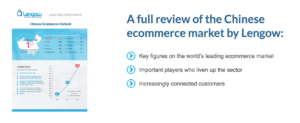China: Olympic Champions, and Ecommerce Champions
22/08/16
2'
Over the last few weeks, China has proved its mastery in a range of Olympic events. However, its prowess is not limited to sporting events: it is the global ecommerce leader.

In 2015, over 40% of total eCommerce spending around the world came from China, and the Chinese ecommerce market is projected to reach a value of $1.6 trillion by 2018. However, internet penetration remains under 50%, so there is still plenty of potential left in this burgeoning market. It is predicted that by 2020, this will reach 70%; in other words, in four years time, there will be 891 million online shoppers in China alone.
The potential of China cannot be overstated, and ecommerce is a great way for retailers to enter this promising market. What’s more, it can be particularly lucrative for European retailers, as European products are seen as high-quality and prestigious. However, it does not suffice to simply use your European strategy when selling in China, as this market has its own specific features and trends. Neglect these, and your business will likely fail.
For example, retailers need to take into account ‘Single’s Day’, which falls on 11th November. Although relatively unknown elsewhere around the world, this is now the largest online shopping day worldwide, with $14.3 billion spent on this day alone in 2015. What’s more, marketplaces are crucial to selling in China, as 90% of all online retail sales are generated via these platforms. The top marketplaces Taobao and Tmall Global (which belong to Alibaba Group), and JD. Amazon is relatively unpopular in China, with only 2.2% of the market share. However, Amazon has faced criticism for not adapting their site to suit Chinese consumers, which proves just how important it is to adapt your offering accordingly.

However, there is one trend which transcends borders: m-commerce. Over $333 billion worth of sales were made using mobile devices in 2015, representing an 85% increase from the year before. China has over 700 million mobile phone users, which may explain why a recent study by iResearch revealed that 60% of online shoppers in China use 2-3 shopping applications when buying a product online. M-commerce is also favourable for shoppers because the top payment method of choice is online wallets (31%), which are often available in application form.
Selling in China doesn’t have to be difficult. Ask for a free demo now to find out how Lengow can help.
To find out more about selling in China,
Your e-commerce library
Sign up for our newsletter
By submitting this form you authorize Lengow to process your data for the purpose of sending you Lengow newsletters . You have the right to access, rectify and delete this data, to oppose its processing, to limit its use, to render it portable and to define the guidelines relating to its fate in the event of death. You can exercise these rights at any time by writing to dpo@lengow.com

Trending Posts
Marketing channels
ChatGPT Ads and advertising on GenAI Search Engines: what you need to know
Advertising on generative AI-based search engines (GenAI) marks a new era in digital marketing. After two decades dominated by traditional…
22/05/25
6'
Marketing channels
Reddit and Social Commerce: When Users Take Back Control
Before buying anything, we compare. We hesitate. And more and more often, we end up typing the product name followed…
30/06/25
8'
Marketing channels
How to Sell on TikTok in 2025: The Ultimate Guide to Success
To sell or not to sell on TikTok? That remains a question many brands ask themselves. But here’s what you…
03/02/25
7'
E-commerce Trends
E-Commerce 2025: The New Rules of Digital Retail
What’s going on in e-commerce? A lot. If 2024 was the year brands got comfortable with marketplaces, AI tools, and…
11/07/25
8'
Marketing channels
Omnichannel Strategy: The Best Examples of Successful Brands
Consumers interact with brands through multiple channels, including online, in-store, and mobile apps. More than 90% of consumers expect a…
04/04/25
5'





